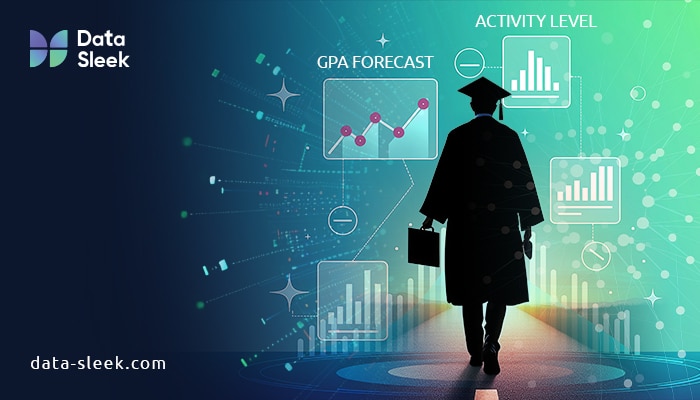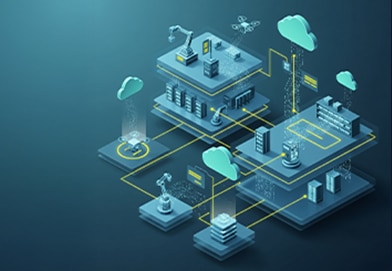Key Takeaways
- AI-powered data warehousing enables institutions to consolidate all their student, faculty, and operational data in one place, facilitating a deeper understanding of it.
- By using predictive analysis, institutions can identify students who are most likely to struggle and intervene early to provide them with support.
- Data-driven strategies enable institutions to optimize their resource utilization, streamline operations, and effectively plan for the future.
- Modern AI tools bridge the data skills gap by simplifying complex analysis for non-technical users.
The Data Revolution in Higher Education
The need for a data warehouse in higher education institutions is skyrocketing as universities and colleges continue to collect more data, ranging from online learning systems to faculty research and student enrollment. However, even with all this data, most institutions struggle to make sense of it all and turn it into clear plans.

AI-powered data warehousing provides a solution by combining all data and utilizing intelligent analysis. It helps institutions find patterns, predict what’s needed, and make faster, smarter decisions. This approach is more than a mere tech improvement; it’s a fundamental shift in how institutions run, adapt, and lead in a world driven by data.
Understanding Modern Educational Data Warehousing
What Exactly is an Educational Data Warehouse?
An educational data warehouse is a repository that collects, organizes, and stores data from various education systems. These include learning management systems (LMS), student information systems (SIS), enterprise systems like SAP or Workday, research databases, financial systems, event platforms, marketing or communication platforms like Marketing Cloud, and campus operations tools.
While traditional databases primarily focus on day-to-day transactions, modern data warehouses handle complex analysis and reporting. The result is the consolidation of information across departments that traditionally operated in isolation.
Key Data Types Collected in University Environments
Data collected in modern university environments aims to support administrative research, academic services, and student life. These data types comprise several categories:
- Student Data: This primarily includes student information such as academic records, financial data, admissions data, demographic data, behavioral data, and attendance and engagement records. The information is mainly sourced from student information systems (SIS).
- Staff Data: This entails HR data, professional records, and demographic data. Its primarily collected from human capital management (HCM) solutions like Workday or SAP.
- Course Data: it includes enrollment data, course catalog data, learning materials, and assessment data from learning management systems (LMS) like Blackboard or Canvas.
- Research Data: Lab records, grants and funding, and publication data from internal research administration systems.
- IT Data: Security logs, device data, and network usage.
- Event and Engagement Data: Tracks registration, attendance, and participant engagement for university hosted events. Data is often sourced from platforms like Hopin or Cvent.
- Marketing and Communication Data: Includes SMS notifications, email campaigns, open rates, and outreach metrics. It’s often managed through platforms like Salesforce Marketing Cloud.
- Financial and Operational Data: Encompasses procurement, budgeting, resource planning, and facilities usage. Data managed through ERP systems like SAP.
Solving the Siloed Data Problem
In educational institutions, data fragmentation is common across departments or systems. This lack of cohesive data results in inconsistencies, redundancies, poor data quality, and limited visibility of data across departments. In higher education institutions, a data warehouse centralizes all data.
For instance, institutions can create centralized data warehouses for financial information, integrating student records, communication data, and development and alumni relations (DAR). This unified approach helps DAR teams better predict donor behavior understand alumni engagement, and tailor outreach efforts.
How AI Transforms Educational Data: Beyond Basic Analytics
Traditional data analysis involves descriptive reporting, which is the summarization of everything that has happened in the past. However, AI-powered analytics transforms data analysis into predictive and prescriptive reporting, thus reshaping how institutions operate, teach, and make strategic decisions.
The Analytics Evolution in Higher Education
- Descriptive Analytics: Reports past events or what happened (e.g., dropout rates, average grades, etc.).
- Diagnostic Analytics: Focuses on understanding the causes (why did it happen?).
- Predictive Analytics: Forecasts future outcomes (what will happen).
- Prescriptive Analytics: Recommend actions (what we should do about it).
Thanks to AI-powered data warehousing, institutions can move from reactive to proactive approaches. Incorporating AI would help administrators and educators address challenges before they escalate.
Machine Learning Algorithms and Data Interpretation
Through machine learning algorithms, institutions can interpret data differently based on the structure, type, and intended use. These algorithms use a statistical and unique mathematical approach to identify relationships, patterns, or rules in data. Institutions can therefore interpret education data through:
- Decision Trees: Use branching rules to interpret data.
- Neural Networks: Identify complex, nonlinear relationships using multiple variables.
- Clustering Algorithms: Create groups without needing labels to enhance personalized interventions.
These algorithms provide a different lens, enabling institutions to uncover insights that traditional analysis models would miss.
Identifying Crucial Trends Through AI-Powered Analytics
Through AI-powered analytics, institutions can analyze multiple datasets to gain a deeper understanding of attitudes, behaviors, and preferences across academic environments. This approach can help them move beyond manual surveys and anecdotal feedback to uncover shifts in student engagement, values, and dynamics.
Student Success Pattern Recognition
AI algorithms can detect patterns in student performance data that most human analysts might miss. They can analyze historical data from multiple students, thus identifying subtle indicators of potential academic struggles days or weeks before they are apparent through traditional methods.
For example, machine learning models can help correlate seemingly unrelated factors – such as changes in assignment submission timing, digital resource usage, and campus building access patterns – to predict academic disengagement accurately.
Uncovering Non-Obvious Correlations
AI-powered analytics can find hidden connections in student data that traditional analysis models might miss. For example, it could show that students struggling academically participate less in discussions or access online learning materials late, a link that an educator might not easily see.
Such insights open new avenues for institutional improvement. AI, therefore, empowers educators and institutions to go past generalizations to address individual student needs with accuracy.
Early Warning Systems for Academic Challenges
For students, AI-powered analytics can help them constantly track their progress, whether it be in grades or involvement. These analytics can help institutions identify problems or struggling students earlier than traditional analysis models.
Therefore, instead of waiting for poor grades, machine learning models can quickly analyze a large amount of information and identify patterns to suggest when students need support. This early warning system enables institutions to focus their aid on students who are most in need, ensuring the most effective use of resources.
Revealing Institutional Strengths and Weaknesses
Institutions can also analyze data from different departments to identify areas that need improvement and determine which services are working most effectively for students. For example, AI-powered analytics can reveal new mentorship programs that are improving student engagement. It can also highlight larger problems, prompting institutions to investigate and implement informed changes.
Benchmarking Against Similar Institutions
Institutions can also look outside their walls to compare data more intelligently. Instead of only assessing the overall numbers of similar institutions, they can take into account aspects, such as the size of institutions and student backgrounds, to make fairer comparisons. With this data, universities and colleges can identify where to invest their resources.
Personalized Education Pathways: The Future of Learning
With all the data available now, colleges are shifting from traditional teaching to a more personalized approach. AI-powered data plays a huge role in personalized learning. It enables institutions to collect various types of student information and utilize AI to identify hidden patterns.
This data-driven approach enables institutions to understand how students learn, thereby personalizing the entire experience for larger groups. The tailored approach changes how students interact with their education, from the materials they study to the support they receive.
Adaptive Learning Recommendations
By utilizing AI to analyze student performance data, institutions can recommend learning materials and courses to align with a student’s strengths, learning styles, and weaknesses. These adaptive systems can change based on the learner’s progress, ensuring their educational journey is efficient and relevant. These recommendations might include:
- Supplementary Resources: Recommend specific readings, exercises, and videos tailored to help students in weak learning areas.
- Course Sequencing: Depending on a learner’s understanding, suggest foundational subjects before progressing to complex courses.
- Pacing Suggestions: Adjust workload or deadlines depending on a learner’s performance trends and engagement patterns.
Since AI is consistently monitoring the student’s progress, it can also predict when help is needed. Therefore, when a student starts to disengage, the institution or educator can get an alert to offer support in the right way.
The “Digital Learning Twin” Concept
Some institutions are starting to use “digital learning twins,” which entail virtual versions of individual students powered by data. These twins can help predict how a student will perform, much like virtual models in engineering predict how machines will function.
This digital twin constantly learns from a student’s grades, habits, engagement, and extracurricular activities. By simulating these scenarios, the digital twin can show students their potential GPA and graduation time.
Operational Intelligence for Administrative Excellence
Modern institutions are increasingly relying on AI and data to gain a deeper understanding of their day-to-day operations. This “operational intelligence” is essential for automating processes, making informed administrative decisions, and optimizing facilities.

Resource Optimization Through Predictive Modeling
Data helps institutions make more informed choices on how to utilize their resources effectively. Through predictive modeling, institutions can identify past and current trends to make more accurate future predictions. The result is notable operational benefits even in:
- Financial Forecasts: Machine learning algorithms can create accurate budget predictions by analyzing expenditure trends and funding patterns.
- Facilities Management: Predictive models can improve availability and reduce costs by optimizing resource allocation and the classrooms based on past trends.
- Workforce Planning: Thanks to advanced analytics, institutions can predict staff needs based on program growth, retirement patterns, and enrollment trends.
Automating Administrative Workflows
Blending AI and comprehensive data warehousing enables the automation of administrative work, helping institutions reduce errors. AI systems can manage routine processes like:
- Automatically creating compliance reports using reliable data.
- Faster financial aid processing that identifies eligible students.
- Innovative scheduling systems that consider the learners’ needs, educators’ preferences, and facility availability.
- Automatically adjusting budget plans using real-time financial and enrollment data.
By making these operations more intelligent, institutions become more efficient and gain a deeper understanding of their data. This approach enables administrators to focus on future projects instead of managing day-to-day tasks.
Research Enhancement and Innovation Acceleration
Since data is a key resource in institutions, AI can help researchers work efficiently and quickly generate novel breakthroughs. It also assists researchers in collaborating efficiently and finding solutions for necessary projects.
Cross-Disciplinary Connections
AI systems can now identify potential cross-disciplinary collaboration opportunities by linking information from different fields. To achieve this, the systems can link information from various faculties within the institution to identify connections that researchers working alone might not notice.
Research Funding Optimization
Institutions require the proper funding to drive innovation. AI-powered analytics streamlines these opportunities by pinpointing the institutional strengths. The systems analyze past grant successes, research trends, and tactical goals to find funding opportunities that will yield results.
Ethical Considerations and Privacy Protection
When institutions adopt AI and data-driven analysis, safeguarding student privacy and establishing ethical guidelines are crucial cornerstones for responsible progress.
Balancing Analytics Power with Privacy Rights
While using data in decision-making has helped institutions improve operations and learning, it’s also important to protect student privacy. Therefore, institutions must find a balance between using data for analysis and respecting the students’ privacy. Critical ethical considerations include:
- Data Privacy: Ensure compliance with regulations such as FERPA and GDPR while enabling efficient data analysis.
- Algorithmic Bias: Regularly check AI systems to ensure they don’t unfairly favor or disfavor certain groups.
- Transparency: Clearly explain how AI-driven suggestions are made in an easy-to-understand manner.
- Human Oversight: Ensure that important decisions, such as grading, admissions, and student support, are reviewed by individuals.
- Informed Consent: Communicate clearly to students regarding the collected data and its intended use, and ensure that students have a say in its utilization.
Prioritizing ethical safeguards and student rights enables institutions to develop data systems that are powerful, trustworthy, and aligned with fundamental educational principles.
Ethical and Transparent AI Use
Responsible use of AI in institutions means more than just protecting privacy. Institutions must actively determine what constitutes fair and ethical use of technology for them. Administrative decisions can inform themselves by establishing guidelines for the development and use of AI in a manner that supports student well-being and practical education.
Implementation Roadmap: Getting Started with AI-Enhanced Data Warehousing
Assessment: Understanding Your Institution’s Data Maturity
Before implementing AI-enhanced data warehousing, institutions must understand their data maturity by evaluating areas like:
- Data Quality and Completeness: Ensure the timely, accurate, and comprehensive collection of institutional datasets.
- Analytics Capabilities and Expertise: Have the correct tools and talent to interpret and act on data insights.
- Integration Capabilities Across Systems: Ensure existing platforms can effectively exchange data.
- Governance Structure and Policies: Have clear frameworks for decision accountability, data use, and privacy compliance.
- Technical infrastructure Readiness: Ensure the scalability and security of the current infrastructure.
Building the Right Team
Successfully utilizing AI to enhance data storage requires more than just technical expertise. It also requires a team with diverse skills and the ability to drive actionable results. This team should include:
- Data experts that design secure data systems that can integrate and work seamlessly with other systems.
- AI specialists to create models and ensure the ethical use of AI.
- Education experts who understand the institution’s goals and education methods.
- People from different departments who can drive change.
- Leaders who support the project by providing resources and solving problems.
Case Studies: Potential Applications in Higher Education
Student Success Initiatives
Institutions could implement early warning systems to identify students in need of additional support before it becomes obvious they’re struggling. By assessing data such as course participation, assignment delivery, and academic background, the intervention systems could provide proactive and tailored support.
Resource Optimization Opportunities
Universities could utilize AI analysis to gain a deeper understanding of faculty workload, classroom utilization, and the allocation of technology resources. Doing so would help identify areas where they can be more efficient and better utilize the available resources.
Research Collaboration Enhancement
Data warehousing systems could connect researchers with matching expertise and interests across departments. By eliminating silos, institutions can foster teamwork across different fields, sparking innovation and accelerating research breakthroughs.
Future Horizons: Emerging Trends in Educational AI
Integration with Learning Environments
Future technologies could combine AI’s ability to understand data with augmented and virtual reality. This combination would help create learning environments that instantly adapt to each learner’s performance and their interests. The results? Making education personal for more learners by changing passive lessons into engaging and immersive experiences.

Natural Language Interfaces for Data Access
Educational institutions are also exploring the use of AI-powered conversational tools, such as chatbots, to assist faculty and administrators in asking questions about complex data in a natural manner. Accomplishing these goals would eliminate technical difficulties, making data easier to use and understand, even for those who aren’t data experts.
Advanced Resource Management
Eventually, AI systems could help institutions optimize their operations, including class scheduling and energy management. They will achieve this by analyzing activity patterns and the institution’s needs. This results in more efficient use of online tools and physical tools across the campus.
Continuous Learning Systems
The next generation of educational AI could feature algorithms that learn and update predictions as new data comes in. This continuous improvement could increase the accuracy and effectiveness of AI interventions over time as they adapt to the institution’s evolving needs.
FAQs About AI-Powered Data Warehousing in Higher Education
How does data warehousing differ from traditional databases?
Traditional databases are designed for everyday tasks, and they perform these actions efficiently. Data warehouses, on the other hand, examine data in detail, gathering information from multiple sources to provide in-depth reports and support informed decision-making.
What kinds of data can universities include in a data warehouse?
The data warehouse in higher education institutions can hold student data (enrollment, engagement, and academic performance), teacher data (assignments, research), operational data (financial records, facilities), and external data.
What privacy considerations are essential?
Institutions must have robust security measures, limit personnel access to sensitive information, and comply with data privacy laws, such as FERPA.
Can smaller institutions benefit from these technologies?
Yes. Cloud-based systems have enabled smaller institutions to utilize powerful data warehousing tools.
What skills are needed for implementation?
Technical skills, change management, and educational understanding.
How do these systems integrate with existing university technologies?
Modern data warehousing platforms are designed to connect smoothly with systems that institutions currently use, such as learning management systems, student information systems, finance systems, and HR systems.
Conclusion: Strategic Considerations
The integration of AI and data warehousing is a big opportunity for higher education institutions. By combining data from research, operations, and teaching, institutions can make smarter and faster decisions.
Going forward, higher education institutions that prioritize the effective use of data, have ethical guidelines and promote teamwork between faculties will be among the leaders in the digital era. Data Sleek provides customized data warehousing solutions to help streamline operations, enhance compliance, and unlock valuable insights. Let our expertise help your institution navigate the complexities of data analytics and integration.



